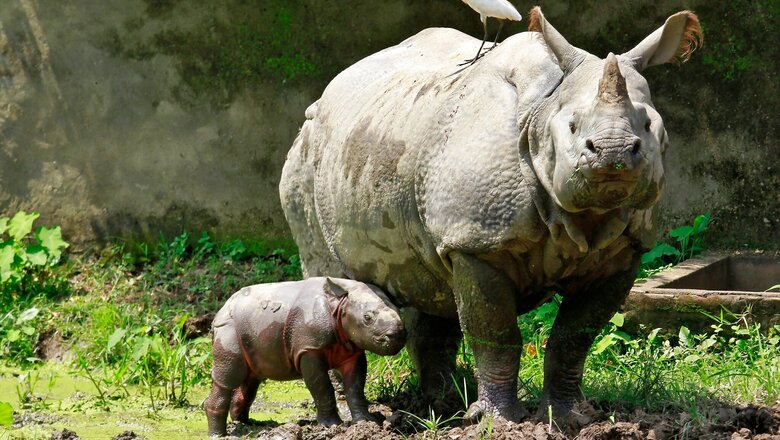
views
As Forest Rangers and staff at the Pobitora Wildlife Sanctuary keep their office gates open for starving animals to graze in their courtyards, officials point out that rhinos going near human settlements in search of food raises fresh concerns.
“This is the first time that a mother and calf rhino has come so close to us. It was less than 10 feet away from our doorstep on Friday morning. They were grazing on the grass that has overgrown due to the incessant rains,” said Kaziranga National Park Ranger, Mukul Tamuli.
The forest official said that while it was strange for the rhinos to be oblivious to human presence, the incessant rains and floods across Assam for the past weeks have led to the submerging of all grasslands loss of habitat for a large number of animals.
However, experts point out that rhino’s moving out of flood-hit Pobitora wildlife sanctuary located in Morigaon district of Assam is not new. Since more than 95 per cent of the sanctuary submerges underwater due to the floods, scarcity of food has become acute in the sanctuary which boasts of the highest Rhino density in the world. The wildlife park is home to around 102 endangered one horn rhinos according to the last census carried out at the end of 2018.
The Assam Floods this year have claimed 97 lives so far and affected more than five million people across 25 districts of the state. Almost all the forest camps including those in Tamuldubi, Bangal Dubi and Tuplung in the sanctuary has submerged underwater leading to movement by forest guards inside the sanctuary a difficult process.
Although the sight of a female Rhino with her calf strolling outside the office areas of the sanctuary might fascinate many, the matter is serious, says MK Yadava, Additional Principal Chief Conservator of Forests (Wildlife) and Chief Wildlife Warden, Assam.
“For the first time, we had to provide them with grass and fodder from outside,” he added.
Boats loaded with fresh grass were brought into the highlands inside the park to provide fodder to the stranded rhino’s of the sanctuary. “Napier grass and the dol grass that have been provided by the veterinary department is not an ideal choice for the rhinos but we need to manage,” said the Chief Wildlife Warden.
Currently, five rhinos are taking refuge in three homes in Rajamayong village in the vicinity of the sanctuary. “We are in constant touch with villagers,” said Tamuli. “People are cooperating and have been looking after the rhinos. Any damages to their homes will compensate, he said.
The Pobitora Wildlife Sanctuary, situated in the flood plains of river Brahmaputra was initially a grazing reserve for cattle of erstwhile Nagaon district. The region came into limelight during the year 1961-62 for the sighting of the first one-horned rhino (Rhinoceros unicornis).
During that time, a few rhinos strayed out of Lawkhowa and Orang Wild Life Sanctuaries and gradually became residents. Two such grazing reserves comprising 38.83 square kilometres was declared as reserve forests in 1971.
In 1987, Pobitora was declared a wildlife sanctuary covering an area of 16 square kilometres. Presently the sanctuary is surrounded by 20 revenue villages.
However, apart from habitat loss due to the rains, in-breeding of Rhinos due to lack of space in the sanctuary has been a worrying factor for wildlife conservationists.
“According to reports, the Rhino here are suffering from inbreeding depression. In 1998, the Raja Mayong Reserve Forest Hill was added to the existing Pobitora Reserve Forest (RF) but is only on paper. The 11 square kilometres “khas” land that connects both the RFs have been ‘handed over’ but practically it is not with us,” said Yadava.
Due to space constraints and lack of clarity on the forest lands, the Rhinos are unable to move to the Raja Mayong RF, which is its habitat and has resulted in overcrowding of Pobitora.
“Space for the Rhinos have decreased and this, in turn, has led to inbreeding among the Rhino population” explained the Chief Wildlife Warden. Several letters have been written to the Deputy Commissioner of Morigaon on the issue, but nothing concrete has been done so far, he said.
Besides rhinoceros, other wildlife animals found are Leopard, Leopard Cat, Fishing Cat, Jungle Cat, Feral Buffalo, Wild Pigs, Chinese Pangolins etc.
The Pobitora Wildlife Sanctuary is also an Important Bird Area with over records of 375 species of both migratory and resident birds of 46 families. With over 14 species listed in the Indian Red Data Book, the wildlife park also has 27 species of reptiles nine species of amphibians.















Comments
0 comment